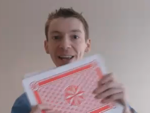 James Grime, known to YouTube viewers as singingbanana, is back! This time, he's performing a rather interesting experiment/magic trick.
James Grime, known to YouTube viewers as singingbanana, is back! This time, he's performing a rather interesting experiment/magic trick.
I've talked about this principle before, but I don't want to ruin it by giving the principle away before you've had a chance to enjoy it. The first 90 seconds of the following video are mainly to clarify the instructions. After that, the actual experiment begins:
Did he get your card? Remember, it's an experiment, so it may not have worked.
Whether or not that worked, here's a similar experiment to try. Instead of cards, this version uses the first sentences of the US Declaration of Independence. Go to that link, and try out Martin Gardner's presentation of this same principle.
Intrigued? How could these routines work a majority of the time? Indeed, with the right set-up, it is possible to guarantee that the principle works every time! Still, the question remains, how is it possible?
Both of these routines are based on a principle developed by physicist Martin David Kruskal, and is known as the Kruskal Count.
A simple and understandable explanation of exactly how this principle behind the Kruskal Count works is shown in the article, Up The Magician's Sleeve. You can also try this approach yourself with various coins or poker chips of various colors.
With a single deck in this trick, the probability of it working is roughly 84%, which is why the version of the video may not have worked for you. When the same trick is performed with two decks, the probability of the trick working goes up to roughly 95%!
Once you get an idea of how the Kruskal Count works, you start to realize that it will work with anything in a specific order. This is why it also works with the Martin Gardner version above that used the US Declaration of Independence.
It can also work with the opening paragraphs of your favorite book or poem, as well. In fact, I suggested this approach for memorized poems in one of my Memory Binder posts. Computer Science for Fun has a great Wizard of Oz version.
What other types of things involve some chain? How about a clock? Here's a great clock version, based on a similar routine that David Copperfield performed on his Unexplained Forces special:
This is an interesting approach, first developed by Jim Steinmeyer, that combines the Kruskal Count with a circular chain.
This seems like a good place to wrap up the post and let you start exploring. What other routines for the Kruskal principle can you find, with or without the circular idea from the clock trick above? I'd love to hear about it in the comments if you come up with a great version!




No Response to "Last To Be Chosen"
Post a Comment